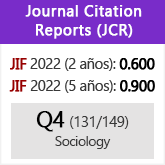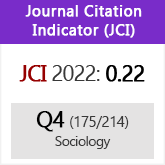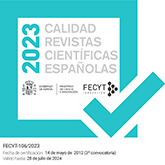Las expectativas educativas de la población inmigrante en Navarra. ¿Optimismo inmigrante o efectos de escuela?
DOI:
https://doi.org/10.3989/ris.2013.02.22Palabras clave:
Desventaja educativa, Expectativas educativas, Optimismo inmigranteResumen
Este trabajo explota los micro-datos de la Encuesta de Evaluación de la Educación Secundaria realizado en Navarra en 2010 para estudiar las expectativas educativas de la población escolar en función de su estatus migratorio. En sintonía con la literatura internacional, identificamos en Navarra la confirmación de lo que otros estudios internacionales han denominado “optimismo inmigrante” es decir, el hecho de que las expectativas de los estudiantes de origen inmigrante sean, en media, superiores a las de los autóctonos, dado su rendimiento educativo previo y la situación socioeconómica de sus familias. Identificada esta regularidad, el trabajo explora las causas de este diferencial inmigrante-autóctono sugiriendo que son las características individuales y/o familiares de los inmigrantes las que producen este desajuste entre expectativas y rendimiento. La distribución de inmigrantes en el mapa escolar navarro o las características de la escuela a las que asisten los estudiantes que forman parte del estudio, parecen argumentos poco útiles para entender el optimismo inmigrante.
Descargas
Citas
Álvarez de Sotomayor Posadillo, A. 2011. El rendimiento académico de los alumnos inmigrantes en España: un estudio de caso. Tesis doctoral. Granada: Universidad de Granada.
Boliver, V. 2006. "Social inequalities in access to higher status universities in the UK: the role of university admissions decisions", Sociology Working papers. Oxford, 2006-7.
Borjas, G. 1995. "Ethnicity, neighbourhoods and human capital externalities", American Economic Review, 85, 365–390.
Boudon, R. 1974. Education, opportunity, and social inequality; changing prospects in Western society New York: Wiley.
Breen, R. y J. H. Goldthorpe. 1997. "Explaining Educational Differentials: Towards a Formal Rational Action Theory." Rationality and Society 9: 275-305. http://dx.doi.org/10.1177/104346397009003002
Brunello, G. y L. Rocco. 2011. "The effects of immigration on the school performance of natives: cross country evidence using PISA test scores" IZA discusión papers 5479.
Cebolla-Boado. H. 2013. Introducción Al Análisis Multinivel. Centro de Investigaciones Sociológicas: Madrid.
Cebolla-Boado, H., A. González Ferrer y Y. Soysal. 2013. "The Interpleay between families and schools: immigrant and native differentials in educational outcomes", Instituto Juan March, Working Papers, 280.
Cebolla-Boado, H. y L. Garrido Medina. 2010. "The Impact of immigrant concentration in Spanish schools" European Sociological Review 27: 606-623. http://dx.doi.org/10.1093/esr/jcq024
Cebolla Boado, H. 2011. "Primary and Secondary effects in the explanation of immigrant's educational disadvantage", British Journal of Sociology of Education 32(3):407-430. http://dx.doi.org/10.1080/01425692.2011.559341
Cebolla-Boado, H. 2008. "Del preescolar a las puertas de la universidad: un análisis de las trayectorias escolares de los estudiantes inmigrantes en Francia", Revista Internacional de Sociología 51:79-103.
Cebolla-Boado, H. 2007. "Immigrant concentration in Schools: peer pressures in place?" European Sociological Review 23:341- 356. http://dx.doi.org/10.1093/esr/jcm008
Dietz, R. D. (2002). "The Estimation of Neighbour- hood Effects in the Social Sciences: An Interdisci- plinary Approach". Social Science Research, 31, 539–575. http://dx.doi.org/10.1016/S0049-089X(02)00005-4
Erikson R., J.H. Goldthorpe, M. Jackson, M. Yaish and D.R. Cox. 2005. 'On Class Differentials in Educational Attainment', Proceedings of the National Academy of Sciences. Vol. 102:27, pp. 9730-33. http://dx.doi.org/10.1073/pnas.0502433102 PMid:15976024 PMCid:PMC1172254
Evans, W. N., Oates, W. E. y Schwab, R. M. 1992. &qquot;Measuring Peer Group Effects", Journal of Political Economy, 100: 966–991. http://dx.doi.org/10.1086/261848
Fekjaer, S.N. y G.E. Birkelund. 2007. "Does the ethnic composition of upper secondary schools influence educational attainment" European Sociological Review 23: 309-323. http://dx.doi.org/10.1093/esr/jcm003
Gambetta, D. 1987. Were They Pushed or Did They Jump? New York: Cambridge University Press. http://dx.doi.org/10.1017/CBO9780511735868
Goyette, K. y Y. Xie. 1999. "Educational expectations of Asian American youths: Determinants and ethnic differences". Sociology of Education, 72, 22-36. http://dx.doi.org/10.2307/2673184
Haller, A. O. 1982. "Reflections of social psicology of status attainment", Pp. 3-28, en Structure and Behaviour: Essays in honour of William Hamilton Sewell, R. Jausaer, D. Mechanic, A. O. Haller y T. Hauser (eds). Nueva York, Academic Press.
Heath, A. F., C. Rothon, E. Kilpi. 2008. "The Second Generation in Western Europe: Education, Unemployment, and Occupational Attainment." Annual Review of Sociology, 34: 211-235 http://dx.doi.org/10.1146/annurev.soc.34.040507.134728
Heath, A. y Y. Brinbaum. 2007. "Explaining Ethnic Inequalities in Educational Attainment". Ethnicities, 7(3): 291-305. http://dx.doi.org/10.1177/1468796807080230
Hyman, H. 1953. "The Value Systems of Different Classes", Pp. 488-499, en R. Bendix y S. M. Lipset (eds.) Class, status, and power; a reader in social stratification. Glencoe, Ill: Free Press. Jackson, M (ed). 2013. Determined to Succeed: performance versus choice in educational attainment. Stanford, Stanford University Press.
Jonsson, J.O. y F. Rudolphi. 2011. "Weak performance – strong determination. School achievement and educational choice among children of immigrants in Sweden." European Sociological Review, 27:487-508. http://dx.doi.org/10.1093/esr/jcq021
Kao, G. y Tienda, M. 1998. "Educational aspirations of minority Routh". American Journal of Education, 106: 349-384. http://dx.doi.org/10.1086/444188
Kao, G. y M. Tienda. 1995. "Optimism and Achievement: the educational performance of immigrant youth." Social Science Quarterly, 76:1-19.
Lugo, M.A. (2011) "Heterogenous peer effects" World Bank, Policy Research Working Group Paper 5718. Crul, M. y J. Schneider. 2009. Children of Turkish Immigrants in Germany and the Netherlands: The Impact of Differences in Vocational and Academic Tracking Systems. Mimeo.
Morgan, S. 1998. "Adolescent Educational Expectations." Rationality and Society 10: 131-62. http://dx.doi.org/10.1177/104346398010002001
Murphy, J. 1981. "Class Inequality in Education." British Journal of Sociology 32: 182-201. http://dx.doi.org/10.2307/589445
OECD 2006. "Performance of immigrant students in PISA 2003" en Where Immigrant Students Succeed - A Comparative Review of Performance and Engagement in PISA 2003.
Pearlin, L. I. 1971. Class context and family relations; a cross-national study. Boston: Little Brown.
Portes, A y R. G. Rumbaut. 2001. Legacies: The Story of the Immigrant Second Generation, Berkeley, CA: University of California Press y Russell Sage Foundation.
Portes, A., R. Aparicio, W. Haller y E. Vickstrom. 2011. "Progresar en Madrid: aspiraciones y expectativas de la segunda generación en España" Revista Espa-ola de Investigaciones Sociológicas 134: 55-86. http://dx.doi.org/10.5477/cis/reis.134.55
Sewell, W, H. A., O. Haller y A. Portes. 1969. "The educational and early occupational attainment process" American Sociological Review 34: 82-92. http://dx.doi.org/10.2307/2092789
Sorensen, A. y S. L. Morgan. 2000. "School effects: theoretical and methodological issues" en Handbook of Sociology of Education, M. Hallinan (ed). Kluwer Academic/Plenum Publishers, Nueva York.
Willis, P. E. 1977. Learning to Labour. London: Gower.
Publicado
Cómo citar
Número
Sección
Licencia
Derechos de autor 2015 Consejo Superior de Investigaciones Científicas (CSIC)

Esta obra está bajo una licencia internacional Creative Commons Atribución 4.0.
© CSIC. Los originales publicados en las ediciones impresa y electrónica de esta Revista son propiedad del Consejo Superior de Investigaciones Científicas, siendo necesario citar la procedencia en cualquier reproducción parcial o total.Salvo indicación contraria, todos los contenidos de la edición electrónica se distribuyen bajo una licencia de uso y distribución “Creative Commons Reconocimiento 4.0 Internacional ” (CC BY 4.0). Puede consultar desde aquí la versión informativa y el texto legal de la licencia. Esta circunstancia ha de hacerse constar expresamente de esta forma cuando sea necesario.
No se autoriza el depósito en repositorios, páginas web personales o similares de cualquier otra versión distinta a la publicada por el editor.

















